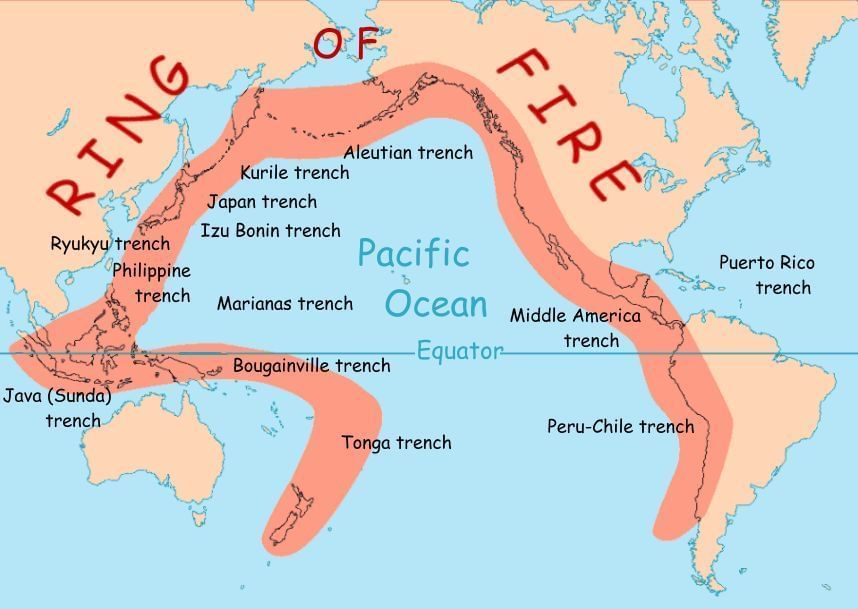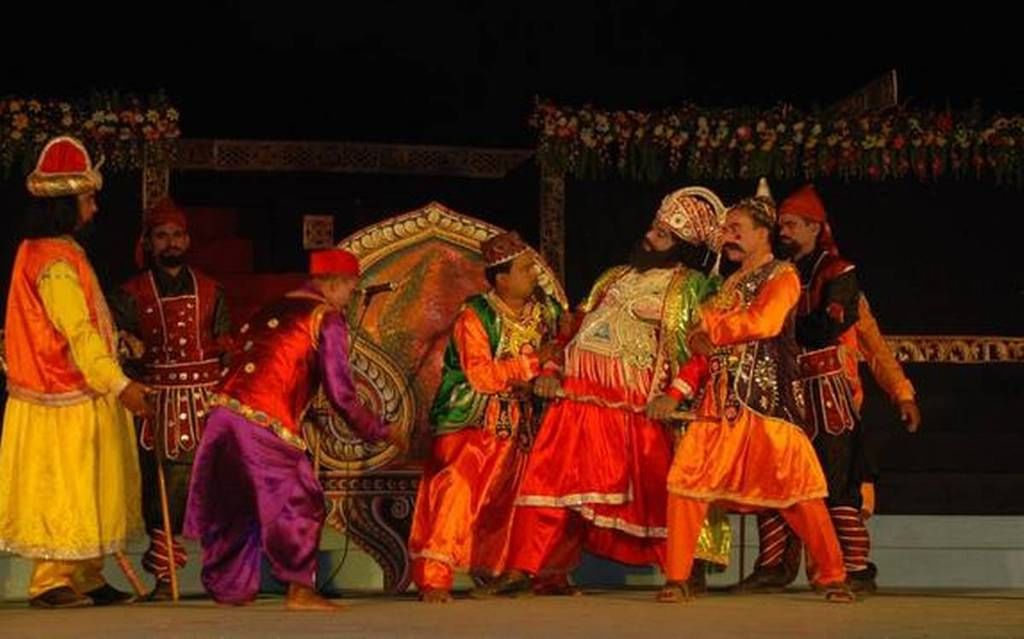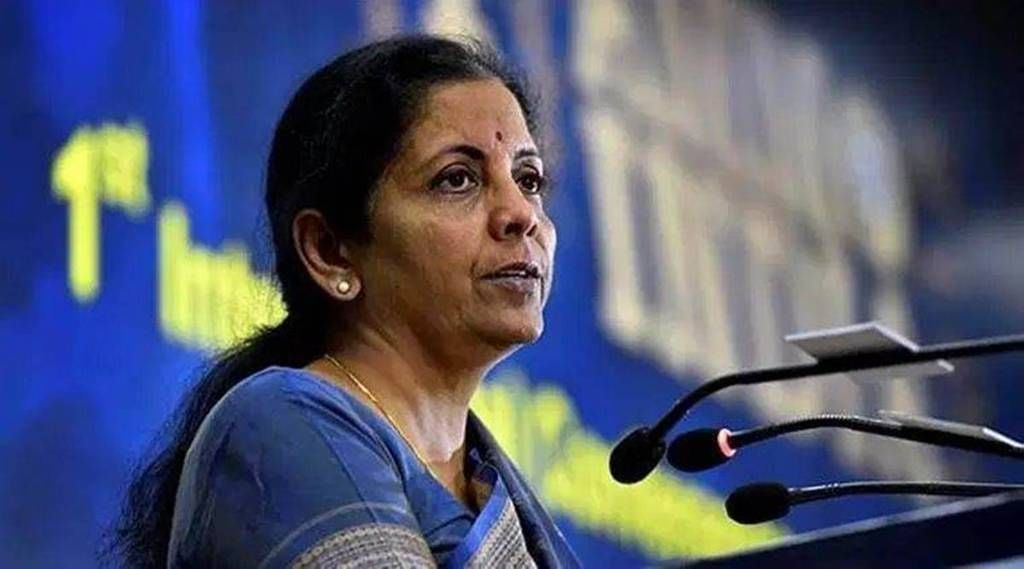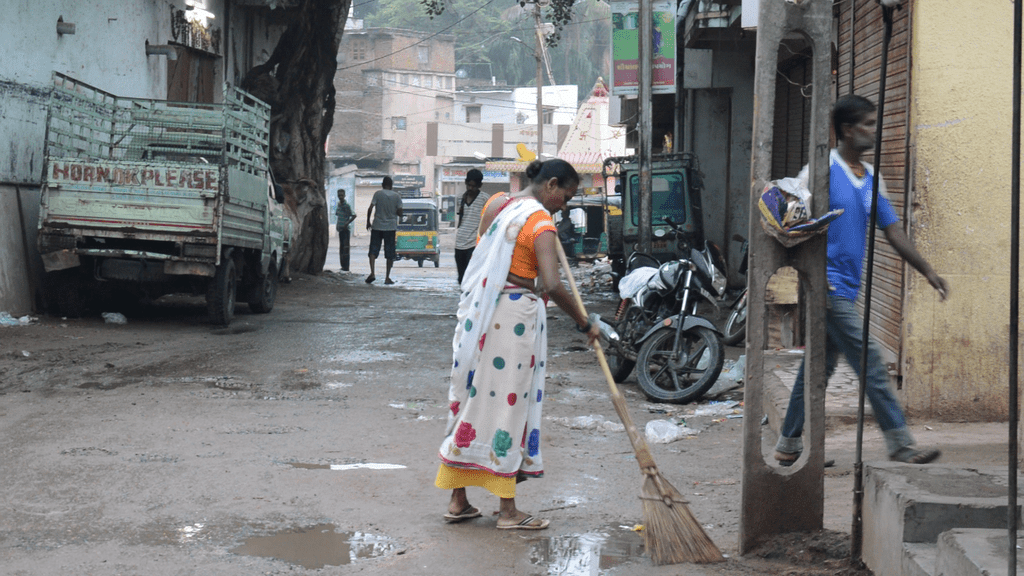UPSC Daily Current Affairs- January 20, 2022 | Current Affairs: Daily, Weekly & Monthly - CLAT PDF Download
GS-I
What is the Pacific ‘Ring of Fire’?

Context
- The Hunga Tonga-Hunga Ha’apai volcano which massively erupted lies along the Pacific ‘Ring of fire’, and is just over 60 kilometers from the island nation of Tonga.
About Pacific ‘Ring of Fire’
- The Pacific ‘Ring of Fire’ or Pacific rim, or the Circum-Pacific Belt, is an area along the Pacific Ocean that is characterized by active volcanoes and frequent earthquakes.
- Volcanic arcs and oceanic trenches partly encircling the Pacific Basin form the so-called Ring of Fire.
- It is home to about 75 per cent of the world’s volcanoes – more than 450 volcanoes.
- Also, about 90 per cent of the world’s earthquakes occur here.
Its spread
- Its length is over 40,000 kilometres and traces from New Zealand clockwise in an almost circular arc covering Tonga, Kermadec Islands, Indonesia.
- It is moving up to the Philippines, Japan, and stretching eastward to the Aleutian Islands, then southward along the western coast of North America and South America.
Seismic activity of the region
- The area is along several tectonic plates including the Pacific plate, Philippine Plate, Juan de Fuca plate, Cocos plate, Nazca plate, and North American plate.
- The movement of these plates or tectonic activity makes the area witness abundant earthquakes and tsunamis every year.
- Along much of the Ring, tectonic plates move towards each other creating subduction zones.
- One plate gets pushed down or is subducted by the other plate.
- This is a very slow process – a movement of just one or two inches per year.
- As this subduction happens, rocks melt, become magma and move to Earth’s surface and cause volcanic activity.
What has happened in recent eruption in Tonga?
- In the case of Tonga, the Pacific Plate was pushed down below the Indo-Australian Plate and Tonga plate, causing the molten rock to rise above and form the chain of volcanoes.
- Subduction zones are also where most of the violent earthquakes on the planet occur.
- The December 26, 2004 earthquake occurred along the subduction zone where the Indian Plate was subducted beneath the Burma plate.
AP govt bans Chintamani Padya Natakam: A noted Telugu folk play

Context
- The Andhra Pradesh government has brought the curtains down on the popular Telugu play ‘Chintamani Padya Natakam’, which has enthralled people for almost 100 years.
About Chintamani Padya Natakam
- It is a stage play penned by social reformer, writer and poet Kallakuri Narayana Rao about 100 years ago.
- In the play, the writer explains how people neglect their families by falling prey to certain social evils.
- It was aimed to create awareness on the Devadasi system and how the flesh trade was ruining many families at that particular period.
- Subbisetty, Chintamani, Bilvamangaludu, Bhavani Shankaram, and Srihari are some of the characters in the play.
Its performance
- The play is named after the main character, Chintamani, a woman born into a family involved in the flesh trade.
- The play focuses on how she attained salvation after repentance.
- Subbi Shetty, a character in the play, loses his wealth to Chintamani and his character is utilised in a way that engages the audience.
- Chintamani play is popular across the state. It has been performed at thousands of places.
- The play continues to engage the audience even today and has become a must stage play in villages during Dasara celebrations.
Why it got banned?
- Began as a social sermon, this play has been increasingly going vulgar.
- Subbi Shetty, who resembles a person of a transgender community, is used to portray the social group in a bad way.
- Obscene dialogues are added to the play in the name of creativity.
GS-II
Devas-Antrix Deal

Context
- The controversial deal between Indian Department of Space’s commercial entity Antrix and Bengaluru-based startup Devas Multimedia has been under the scanner for more than a decade now.
Seizure of Property by Foreign Countries
- The state and its property are protected against legal proceedings in the courts of other countries.
- This emanates from a well-established principle of international law, referred to as State immunity.
- This covers immunity from both jurisdiction and execution.
- However, there is no international legal instrument in force dealing with state immunity in the municipal legal systems of different countries.
- This has created an international void.
- Consequently, countries have filled this void through their national legislations and domestic judicial practices on state immunity.
- Countries like France, follow the concept of restrictive immunity (a foreign State is immune only for sovereign functions) and not absolute immunity (total immunity from all legal proceedings in a foreign court).
- In the context of the execution of BIT awards, it implies that state property serving sovereign functions (diplomatic mission buildings, central bank assets, etc.) cannot be attached.
- However, properties serving commercial functions are available for seizure.
Allocation of Spectrum
- The International Telecommunication Union granted India S-band spectrum in the 1970s.
Handing Over of Spectrum to ISRO
- By 2003, there was a fear that the spectrum would be lost if not used effectively;
- 40 MHz of S-band was given to the Department of Telecom (DoT) for terrestrial use.
- 70 Mhz was to be put to efficiently used by the Department of Space (DoS) or in effect to be used by Indian Space Research Organisation (ISRO).
Global Negotiations for Growth of Communication Systems
- Initially, an MoU was signed by Forge (a US Consultancy) and Antrix in July 2003 for use of the satellite spectrum for the growth of communication systems in India, but later a start-up was envisaged, and Devas Multimedia was floated.
- Following this, Devas Multimedia was able to attract foreign investors.
Signing of the Deal
- In 2005, the deal was signed to provide multimedia services to mobile users using the leased S-band satellite spectrum.
- Under the deal, ISRO would lease to Devas two communication satellites (GSAT-6 and 6A) for 12 years.
- In return, Devas would provide multimedia services to mobile platforms in India using S-band transponders on the satellites.
- As a result of the deal, Devas introduced and utilised technologies like never before and was a huge revenue generator for Antrix.
Scrapping of the Deal
- The deal was cancelled in 2011 on the ground that the auction of the broadband spectrum was mired in fraud.
- The decision was taken in the midst of the 2G scam and allegations that the Devas deal involved the handing over of communication spectrum valued at nearly Rs 2 lakh crore for a pittance.
- The government also held that it needed the S-band satellite spectrum for national security and other social purposes.
Filling of Corruption Charges
- Meanwhile, in August 2016, the Central Bureau of Investigation (CBI) filed a charge sheet against officials from Devas, ISRO and Antrix linked to the deal for “being party to a criminal conspiracy”.
- Amongst them, were the former ISRO chairman G Madhavan Nair and former Antrix executive director K R Sridharamurthi.
International Tribunal Arbitration
- Devas Multimedia initiated arbitration against the annulment at the International Chambers of Commerce (ICC).
- Two separate arbitrations were also initiated under the Bilateral Investment Treaty (BIT) by Mauritius investors in Devas Multimedia under the India-Mauritius BIT and by Deutsche Telekom -- a German company -- under the India- Germany BIT.
- India lost all three disputes and has to pay a total of USD 1.29 billion in damages.
Aftermath of Tribunal Award
- Due to the Indian Government not paying the compensation, a French court has recently ordered the freezing of Indian government property in Paris, to enforce a USD 1.3 billion arbitration award.
Indian Arbitration Scenario
- Recently, the Supreme Court reiterated the Government’s 2011 stance and directed the winding up of Devas Multimedia business in India.
- The Supreme Court also upheld the previous award by the National Company Law Appellate Tribunal (NCLAT) and National Company Law Tribunal (NCLT).
- Antrix filed a plea in the NCLT in January 2021 for the liquidation of Devas in India, which it said was incorporated in a fraudulent manner.
- These tribunals directed the winding up of Devas Multimedia and appointed a provisional liquidator for the purpose.
Why Nusantara has been selected as the new capital of Indonesia?

Context
- The capital of Indonesia is being shifted from Jakarta to East Kalimantan, and will be called Nusantara (situated to the east of Borneo island).
What is the reason for this?
- Increasing environmental issues that Jakarta has been facing.
- Financial inequality.
- Increasing population in Jakarta.
- Jakarta has also been sinking and it has been said that if nothing was done, many parts of the city would submerge underwater by 2050. Indonesia is prone to floods, and Jakarta is surrounded by multiple rivers.
Where is East Kalimantan?
- East Kalimantan is 2,300 kilometres from Jakarta on the eastern side of Borneo island, shared by Indonesia, Malaysia and Brunei.
- The new capital will be located in the North Penajam Paser and Kutai Kartanegara regions. East Kalimantan is an area with immense water resources and habitable terrain.
Concerns
- East Kalimantan is rich in flora and fauna. Therefore, many environmentalists and activists have warned that moving the capital to East Kalimantan would lead to massive deforestation and put the habitat of these animals and trees in danger and damage the ecosystem.
What are the other countries that have changed capitals?
- Indonesia is not the first country to change its capital city. There has been a long list of countries that have changed their capitals for various reasons.
- Brazil changed its capital city from Rio De Janerio to Brasilia, a more centrally-located city, in 1960.
- In 1991, Nigeria hanged the country’s capital from Lagos to Abuja.
- Kazakhstan moved its capital city from Almaty, which is still its commercial centre, to Nur-Sultan in 1997.
- Myanmar changed its capital from Rangoon to Naypyidaw in 2005.
National Commission for Safai Karamcharis gets 3-year extension

Context
- The Union Cabinet has approved a three-year extension of the tenure of the National Commission for Safai Karamcharis (NCSK) that was set to end on March 31.
About National Commission for Safai Karamcharis
- The commission was set up in 1993 under the NCSK Act 1993 for a period of three years, which has been extended since then.
- The NCSK Act is however ceased to have effect from February 29, 2004.
- After that, the tenure of the NCSK has been extended as a non-statutory body from time to time through resolutions.
Why was NCSK set up?
- The commission helps in coming up with programmes for the welfare of sanitation workers.
- It also monitors the implementation of the Prohibition of Employment as Manual Scavengers and their Rehabilitation Act, 2013.
- Till December 31, 2021, 58,098 manual scavengers had been identified.
Need for eliminating Manual Scavenging
- Undignified life (all the 6 Fundamental Rights are compromised, directly or indirectly).
- It directly perpetuates castism. Modern, Secular India has no place for such “professions”.
- It no way suits India’s rising global profile – ‘super power’ aspirations.
- Women are mostly disprivileged since most manual scavengers are dalit women.
What else needs to be done?
- Though the government has taken many steps for the upliftment of the safai karamcharis, the deprivation suffered by them in socio-economic and educational terms is still far from being eliminated.
- Although manual scavenging has been almost eradicated, sporadic instances of their deaths do occur.
GS-III
Eastern Swamp Deer

Context
- Recently, the population of the vulnerable eastern swamp deer has dipped in the Kaziranga National Park and Tiger Reserve (Assam). The eastern swamp deer is extinct elsewhere in South Asia.
- This decline can be attributed to two high floods in 2019 and 2020.
- However, on the brighter side, the eastern swamp deer has now been distributed to areas beyond the Kaziranga National Park, such as Orang National Park and Laokhowa-Burachapori wildlife sanctuaries (Assam).
About Swamp Deer
- There are three subspecies of swamp deer found in the Indian Subcontinent.
- The western swamp deer (Rucervus duvaucelii) found in Nepal.
- Southern swamp deer/Hard Ground Barasingha (Rucervus duvaucelii branderi) found in central and north India.
- Eastern swamp deer (Rucervus duvaucelii ranjitsinhi) found in the Kaziranga (Assam) and Dudhwa National Parks (Uttar Pradesh).
Protection Status of Swamp Deer
- IUCN Red List: Vulnerable
- CITES: Appendix I
- Wildlife Protection Act, 1972: Schedule I
Miss Kerala (Denison Barb)

Context
- A section of aquarists and ornamental fish breeders are surprised that the Denison barb (Miss Kerala), a native freshwater fish species commonly found in parts of Karnataka and Kerala, has been included in Schedule I of the Wild Life Protection Act, 1982 (amendment bill).
About Miss Kerala
- Miss Kerala is also known as Denison barb, red-line torpedo barb and roseline shark.
- Its scientific name is Sahyadria denisonii.
- The fish is featured with red and black stripes on its body.
- It is found in the States of Kerala and Karnataka.
- It has been listed on the IUCN Redlist as Vulnerable, in 2010.
- This species is known to inhabit fast-flowing hill streams and is often found in rocky pools with thick vegetation along river banks.
Why included in Schedule I of WPA?
- Ironically, its beauty is the biggest threat to its survival, as it is highly sought-after in the international aquarium trade, constituting 60 – 65% of the total live ornamental fish exported from India.
- Its numbers are also decreasing owing to habitat degradation due to deforestation, mining, agriculture, urban expansion and hydro-electric projects.
SaaRthi Mobile App

Context
- Recently, Securities and Exchange Board of India (SEBI) has launched Saa₹thi – a mobile app on investor education.
- ‘R’ represents ‘₹’.
About SaaRthi Mobile App
- It aims to create awareness among investors about the basic concepts of the securities market.
- The app will also explain about KYC process, trading and settlement, Mutual Funds (MF), recent market developments, investor grievances redressal mechanism, etc.
Need of SaaRthi Mobile App
- A recent surge is seen in individual investors entering the market, and more importantly a large proportion of trading being mobile phone based.
- According to NSE (National Stock Exchange) data, the share of Individual investors increased to 45% in 2021 from 39% in 2020.
- The NSE is India's largest financial market.
Securities Market
- Securities are financial instruments issued to raise funds.
- The primary function of the securities markets is to enable the flow of capital from those that have it to those that need it.
- Securities markets provide channels for allocation of savings to investments and thereby decouple these two activities.
- As a result, the savers and investors are not constrained by their individual abilities, but by the economy’s abilities to invest and save respectively, which inevitably enhances savings and investment in the economy.
- Example: Equity, Debt securities, etc.
About Securities and Exchange Board of India (SEBI)
- SEBI is a statutory body established on 12th April 1992 in accordance with the provisions of the Securities and Exchange Board of India Act, 1992.
- Its basic function is to protect the interests of investors in securities and to promote and regulate the securities market.
- SEBI Board consists of a Chairman and several other whole time and part time members.
- SEBI also appoints various committees, whenever required to look into the pressing issues of that time.
|
844 docs|613 tests
|
FAQs on UPSC Daily Current Affairs- January 20, 2022 - Current Affairs: Daily, Weekly & Monthly - CLAT
| 1. What is the significance of GS-I in UPSC exams? |  |
| 2. What topics are covered in GS-II in UPSC exams? |  |
| 3. How does UPSC test the candidates' knowledge in GS-III? |  |
| 4. What are the key components of UPSC Daily Current Affairs? |  |
| 5. How can UPSC Daily Current Affairs help in UPSC exam preparation? |  |

|
Explore Courses for CLAT exam
|

|

















